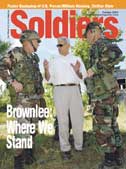Iron Horse Brigade aids Iraqi boy’s recovery
By Spc. Andy Miller
 Lt. Col. Bob Gerhardt, the battalion surgeon for Task Force 1-12 of the 1st Cavalry Division, jokes around with Shimir Isker at the Tisa Nissan district advisory council building in Baghdad. Isker was injured when a bullet struck his head in early April. Gerhardt and others from the 1st Cavalry Division worked to provide treatment and rehabilitation for Isker. He suffers from hemoplegia, or weakness on the left side of his body.
Lt. Col. Bob Gerhardt, the battalion surgeon for Task Force 1-12 of the 1st Cavalry Division, jokes around with Shimir Isker at the Tisa Nissan district advisory council building in Baghdad. Isker was injured when a bullet struck his head in early April. Gerhardt and others from the 1st Cavalry Division worked to provide treatment and rehabilitation for Isker. He suffers from hemoplegia, or weakness on the left side of his body.
Spc. Andy Miller
|
|
|
BAGHDAD (Army News Service, June 30, 2004) -- It took more than two months, but an Iraqi boy who received a brain injury from a bullet has completed his physical therapy and is on his way to recovery.
On June 25, Lt. Col. Kenneth Lee, a physical medicine and rehabilitation specialist with the 118th Medical Support Battalion, walked out of the consultation room the boy was in with a smile on his face.
“It’s a remarkable story,” Lee said. “Actually he’s done his own rehab.”
He said the prognosis for the boy, Shimir, is very encouraging.
“Here is a kid who could be potentially a lawyer, could be an engineer. He could be a businessman or a politician,” Gerhardt said. “Here is a kid who could be a professional some day. So in that sense [his future] is fairly bright.”
This road to recovery began one April day when Spc. Jeffery Ward was providing support for the 1st Cavalry Division forces in the Al Thawra District of Baghdad.
Ward, a medic from the Maverick team of the 1st Battalion, 12th Cavalry Regiment, was stationed at the Tisa Nissan District Advisory Council when the incident occurred.
“I was sitting in my little aid station, and snipers called up and said ‘Get the medic up here real quick,’ ” he said.
When he arrived he said he saw was a crowd of people standing around a fallen Iraqi boy. Under the Coalition rules, Ward was permitted to provide care to the boy.
“Everybody is entitled to emergency care, regardless of who they are or what happened,” Ward said. “So I took a small security element and jumped the wall and ran over to where they were.”
What he found was Shimir, with a right-side head wound combined with left-side paralysis. Shimir was in stable condition so Ward found the boy’s father, Kamill Isker.
“I said, ‘Hey, he needs to go to a hospital immediately,’ ” Ward said. “I cleaned his head up. I put a dressing on it, wrapped his head in gauze, and said ‘All right take him to the hospital to see what’s wrong.’ ”
A few days later, while patrolling the area, Ward checked in with Isker to see how Shimir was doing. He said he found the 12-year-old had suffered a bullet to his brain. When he got back to Camp War Eagle, he told Lt. Col. Bob Gerhardt, the Task Force 1-12 battalion surgeon, about Shimir’s situation.
For the next two months, while Shimir lay in the hospital, Gerhardt and others from Task Force 1-12 worked to see if there was anything they could do to help. After Shimir was released from the hospital, Gerhardt agreed to examine him.
He explained that while the Iraqi health care system is good, with many highly trained professionals, there is a belief among Iraqis that American doctors can work magic. After seeing Shimir, Gerhardt decided maybe there was a way he could help.
“In a way he was certainly cursed to be hit by this thing, in another way he was blessed,” Gerhardt said. “He still knows who he is and where he is, so he’s not catastrophically hurt, thank heaven. But he’s also not in a position where he can be healed back to normal.”
The bullet had left Shimir with hemoplegia, or weakness in his left arm and leg. Iraqi and American doctors who examined him concluded that it would be better to leave the bullet in place, than to perform dangerous brain surgery to attempt removal.
Gerhardt explained that with this type of injury, the normal course of treatment would include physical and occupational therapy. Realizing that Iraq has few resources for physical or occupational therapy, he asked the division surgeon and other coalition forces if they had any ideas. He received good news from the 118th MSB at Camp Victory. There was a physician there who specializes in physical rehabilitation, and was willing to see Shimir.
Task Force 1-12’s contribution to Shimir’s recovery is part of the whole spectrum of military medical operations in Iraq, said Gerhardt. From the beginning when Ward took the initiative, to Lee’s prognosis for Shimir’s future-- military medical humanitarian missions include providing care for locals.
“Was it an extra project beyond what we would normally do? Sure, but it’s nothing that you wouldn’t have done if you were in that position,” Gerhardt said. “And really it was very much a cooperative effort.”
(Editors note: Spc. Andy Miller is from the 122nd Mobile Public Affairs Detachment.)
|


